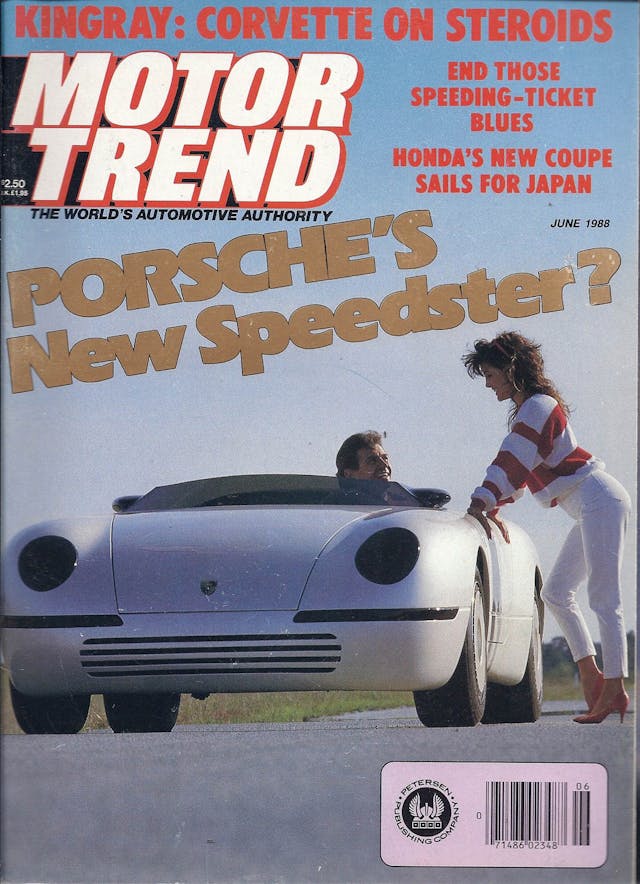Buy the Porsche Boxster’s … Canadian inspiration?
It looks like no other Porsche, because it isn’t just any other Porsche. That sentence alone should be enough for aficionados to fork over $450,000 Canadian ($328,092.34 U.S.) for the 1981 911 Carrera–based Wingho Spexter that’s up for sale on Hemmings. Except there’s even more to the story: Some argue that this roofless one-off provided inspiration for the Boxster.
Motor Trend gushed over it, putting it on the cover of its June 1988 issue. Road & Track fawned over it too. So did Autoweek.
Porsche designers? Not so much—at least, not publicly.
So how did the Wingho Spexter come to be? As Jim Koscs wrote in 2019, it all began with Spex Design, a small Montreal-based manufacturer run by Paul Deutschman and Kell Warshaw. In the mid-1980s, the two created the Elf, “a cheeky roadster body kit based on the first-generation Honda Civic.” A couple dozen were made (Deutschman still owns one).
The Elf caught the attention of Clyde Kwok, a Montreal Porsche aficionado and collector. Kwok’s business, Wingho Auto Classique in Montreal, had started commissioning one-offs, and his futuristic wedge-shaped Concordia II played a fictitious 300-mph prototype called the Black Moon in the forgettable 1986 movie Black Moon Rising. Kwok approached Deutschman with an idea: creating a contemporary Porsche Speedster.
“He owned classic 356 Speedsters,” Deutschman told Koscs three years ago, “and wanted to see that kind of ‘bathtub’ design modernized.”
Kwok’s request, which came months before Porsche showed its own 911 Speedster concept at the Frankfurt Auto Show in September 1987, energized Deutschman, a Quebec native who studied design in England. “I really wanted to show what we could do,” he says.
And what Deutschman did has been turning heads for nearly four decades. The silver metallic Spexter is based on the 911 Carrera Targa, but Deutschman used none of its body panels—he implemented custom sculpted Kevlar and fiberglass instead—while taking the original 356 Speedster’s stripped-down persona to an extreme.
Among its features: rounded front fenders separated from the hood and tipped by dark-tinted, flush-mounted oval headlight covers; an ultra-low plastic windscreen with no A-pillars; a body center section that curves inward and then sweeps outward to envelop the rear wheels; a dark-tinted taillight panel that stretches the width of the car; black bumperettes that flank the license plate; and a large, single tailpipe. The Spexter rides on a set of custom BBS modular racing wheels (sourced from Paul Newman’s racing team through Porsche four-cam expert Cole Scrogham), which feature hand-made center caps and Bridgestone RE71 tires.
Despite all of his modifications, Deutschman told Koscs, “If I had another shot at it, I’d try to pare down the rear of the vehicle.”

Inside the Spexter, a triangular instrument pod houses three large gauges, reminiscent of the original 1950s Speedster (a fourth gauge containing the fuel and oil level meter is located in the trunk), and there are switches for the ignition, hazard flashers, and parking brake located in front of the shifter. The seats are molded into the same fiberglass structure as the dash and console.
The car, which shows only 2325 miles, retains its original (read: Porsche 911 Carrera Targa) five-speed manual transaxle, and the air-cooled, 3.2-liter flat-six engine has been modified to produce a claimed output of 252 horsepower.
The spectacular, one-off masterpiece was a huge hit with the automotive media—even bigger, it seems, than Porsche’s actual Speedster was. “The true spirit of the Speedster is much better captured by the Spexter,” Road & Track wrote at the time. “It is a proper example of coachcraft with wholly original contours that still say ‘Porsche.’”
That likely didn’t sit well with the folks from Zuffenhausen, as Deutschman learned firsthand when he visited Porsche’s design studio a few years after he unveiled his version.
“They had noticed the Spexter,” he told Koscs, “but they didn’t express any kind of obvious significant reaction.”

Perhaps not so coincidentally, when Porsche unveiled a new concept car at the 1993 North American International Auto Show in Detroit, it looked awfully familiar.
“The cover comes off, and it’s called the Boxster, which isn’t too far removed from Spexter,” Deutschman says. “Then, I get a poke in the ribs, turn around, and it’s John Lamm, the Road & Track journalist. And he says, ‘Paul, doesn’t that piss you off?’ It was a bizarre moment. It was flattering that he thought there was some link between the Boxster and my Spexter.”

With that said, while the Boxster went into production four years later and was instrumental in lifting Porsche’s fortunes, the Spexter’s total build count remained at one. “We never took reproducing it too seriously,” Deutschman admits.
The Spexter has remained in Kwok’s collection ever since, but now the rare sports car is looking for a new home. The sale includes the original books and toolkit from the donor vehicle, an original hand-built scale model of the car, and a clean title for a North American 911 Carrera Targa.
As for the car’s historic influence on what ultimately became the Porsche Boxster, you’ll have to rely on your eyes for that.
***
Check out the Hagerty Media homepage so you don’t miss a single story, or better yet, bookmark it. To get our best stories delivered right to your inbox, subscribe to our newsletters.



I only see (barely) a little Boxster design in the front. And I sometimes forget how gorgeous the concept car was. Just about perfect.